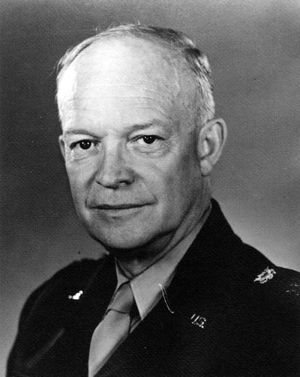Dwight D. Eisenhower: Difference between revisions
imported>Robert W King No edit summary |
imported>Richard Jensen (→1952 Presidential campaign: it's "I Like Ike") |
||
| Line 7: | Line 7: | ||
==1952 Presidential campaign== | ==1952 Presidential campaign== | ||
Part of Eisenhower's campaign was the employment of a very catchy slogan--" | Part of Eisenhower's campaign was the employment of a very catchy slogan--"I Like Ike"--that was produced in part by [[Roy Disney]] and the Citizens for Eisenhower-Nixon. This slogan was illustrated in a short animation<ref>{{cite web|url=http://www.archive.org/details/Eisenhow1952|title=Internet archive, Eisenhower Campaign Spots|accessdate=2007-09-11|date=1952}}</ref>, as well as on wearable pin-on buttons. | ||
==See also== | ==See also== | ||
Revision as of 23:33, 10 September 2007
General of the Army Dwight David Eisenhower ("Ike") (1890-1969) was an American soldier who fought in World War I, was a top commander in World War II, and served as the 34th president of the United States (1953-1961). During the war he first commanded Ally troops in North Africa in 1942, then became the Supreme Commander of the forces that invaded Normandy on D-Day, June 6, 1944.
Eisenhower's political affiliations were unknown for many years and he was courted by both the Democratic and Republican parties. Eventually he declared for the Republicans and was elected to the presidency as a moderate Republican. His presidency was marked by the armistice in the Korean War, the construction of Interstate Highway System, the Eisenhower Doctrine of the Cold War, and moderate domestic policies known as "dynamic conservatism". Although a renowned military figure, at the end of his presidency, Eisenhower issued a famous warning to the American public about the dangers of the military-industrial complex.
1952 Presidential campaign
Part of Eisenhower's campaign was the employment of a very catchy slogan--"I Like Ike"--that was produced in part by Roy Disney and the Citizens for Eisenhower-Nixon. This slogan was illustrated in a short animation[1], as well as on wearable pin-on buttons.
See also
References
- ↑ Internet archive, Eisenhower Campaign Spots (1952). Retrieved on 2007-09-11.
